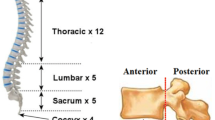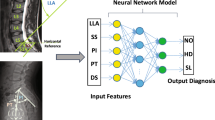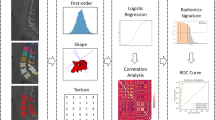Abstract
Anterior Osteoporosis (AOs) in the cervical vertebrae is an osteoporosis complication and a common condition of vertebral irregularity caused by a decrease in bone density and strength, which can lead to fragile bone and fractures. Consequently, it is crucial to detect the AOs irregularity early so that appropriate pharmacological intervention can be done to reduce further complications. To do so via a computer approach, an efficient method that can provide high classification rate is required. Basing on the fuzzy logic theory, this article affords a new method for AOs (classes and severity) classification of the cervical radiography by designing a fuzzy decision tree (FDT) model. The method involves two main processed, namely i) segmentation process which employs the active shape model (ASM) based on the 9-anatomical points representation (9-APR) to segment the cervical vertebra shape boundary (C-VSB) and ii) fuzzy based feature extraction and classifier development, known as FDT method. The fuzzy set along with its membership functions are derived from the resulting C-VSB segment. It operates by extracting a specific angle descriptor (horizontal, vertical, and corner) as crisp input to the fuzzification inter-face to produce reasonable key indexing to the fuzzy interface system. Then, the defuzzification interface converts it into a crisp output that adequately represents the degree of AOs class and severity as appraisal values. The resulting fuzzy then acts as input to a basic concept of if-then rules called FDT to recognise and distinguish between vertebrae presented with/without AOs. Receiver operating characteristic (ROC) and area under curve (AUC) index evaluation methods are examined to offer quantitative evaluation between the medical ground truth versus FDT classifier predicted results. Results obtained on a set of 400 cervical vertebrae images indicate superb classification rate (R > 90 %) which suggest that the proposed FDT as an appropriate solution to AOs classification process for reliable vertebral fracture diagnosis. In summary, the findings confirmed the effectiveness of FDT as an excellent classifier to recognize and differentiate AOs classes and severity thus, able to provide important basis for pathology.



















Similar content being viewed by others
References
Adlassnig K-P (1986) Fuzzy set theory in medical diagnosis. IEEE Trans Syst, Man, Cybern 16:260–265
Alamelumangai N, DeviShree J (2010) Pso aided neuro fuzzy inference system for ultrasound image segmentation. Int J Comput Appl 7:
AnandaKumar K, Punithavalli DM Efficient cancer classification using fast adaptive neuro-fuzzy inference system (fanfis) based on statistical techniques, IJACSA) International Journal of Advanced Computer Science and Applications, Special Issue on Artificial Intelligence (2011) 132–137
Aouache M, Hussain A, Samad SA, Hamzaini A, Ariffin A (2008) Osteoporosis presence verification using mace filter based statistical models of appearance with application to cervical x-ray images 4th Kuala Lumpur International Conference on Biomedical Engineering. Springer, pp 607–610
Aouache M, Hussain A, Samad SA, Zulkifley MA, Zaki WMDW, Hamid HA (2015) Design and development of a content-based medical image retrieval system for spine vertebrae irregularity. Biomed Eng Online 14:1
Aouache M, Hussain A, Zulkifley MA, Ibrahim MF Shape-based boundary segmentation assessment for cervical vertebrae classification 2015 International Electronics Symposium (IES). IEEE, , pp 41–46
Aouache M, Hussain A, Samad SA, bin Abdul Hamid H, Ariffin AK Automatic vertebral fracture assessment system (avfas) for spinal pathologies diagnosis based on radiograph x-ray images International Visual Informatics Conference. Springer, , pp 122–135
Bradley AP (1997) The use of the area under the roc curve in the evaluation of machine learning algorithms. Pattern Recogn 30:1145–1159
Brown CD, Davis HT (2006) Receiver operating characteristics curves and related decision measures: A tutorial. Chemom Intell Lab Syst 80:24–38
Cootes TF, Taylor CJ, Cooper DH, Graham J (1995) Active shape modelstheir training and application. Comput Vis Image Understand 61:38–59
Cootes TF, Taylor CJ et al (2004) Statistical models of appearance for computer vision
David B, Joe F (2002) Humans vertebral column of cervical and lumbar spine anatomy, Lister Hill Centers, http://archive.nlm.nih.gov, 1st edn
Delmas PD, Vrijens B, Eastell R, Roux C, Pols HA, Ringe JD, Grauer A, Cahall D, Watts NB (2007) Effect of monitoring bone turnover markers on persistence with risedronate treatment of postmenopausal osteoporosis. J Clin Endocrinol Metab 92:1296–1304
DominikSlezak SOK, Mirkin DHHBG (2011) Rough sets, fuzzy sets, data mining and granular computing
Eller-Vainicher C, Chiodini I, Santi I, Massarotti M, Pietrogrande L, Cairoli E, Beck-Peccoz P, Longhi M, Galmarini V, Gandolini G et al (2011) Recognition of morphometric vertebral fractures by artificial neural networks: analysis from gismo lombardia database. PLoS One 6:e27277
Ephzibah E, Sundarapandian V (2012) An expert system for heart disease diagnosis using neuro-fuzzy technique. Int J Soft Comput, Artif Intell Appl (IJSCAI) 1:
Guan H, Antani S, Long LR, Thoma GR Comparative study of spine vertebra shape retrieval using learning-based feature selection 2009. CBMS 2009. 22nd IEEE international symposium on Computer-based medical systems. IEEE, , pp 1–7
Güler I, Übeyli ED (2005) Adaptive neuro-fuzzy inference system for classification of eeg signals using wavelet coefficients. J Neurosci Methods 148:113–121
Isador L (2008) What is Osteoporosis? Vertical Health, Texas Back Institute, http://www.spineuniverse.com/conditions/osteoporosis/osteoporosiscondition-center
Kanis JA (2002) Diagnosis of osteoporosis and assessment of fracture risk. The Lancet 359:1929– 1936
Khameneh NB, Arabalibeik H, Salehian P, Setayeshi S Abnormal red blood cells detection using adaptive neuro-fuzzy system, In: MMVR, pp 30–34
Mastorocostas P, Hilas CS A dynamic fuzzy-neural filter for the analysis of lung sounds 2004 IEEE International Conference on Systems, Man and Cybernetics, vol 3. IEEE, , pp 2231–2236
Mastorocostas P, Theocharis J (2005) A recurrent fuzzy-neural filter for realtime separation of lung sounds Proceedings. 2005 IEEE International Joint Conference on Neural Networks, vol 5. IEEE, , pp 3023–3028
Mastorocostas P, Stavrakoudis D, Theocharis J (2008) A pipelined recurrent fuzzy model for real-time analysis of lung sounds. Eng Appl Artif Intell 21:1301–1308
Neagoe V-E, Iatan I-F, Grunwald S A neuro-fuzzy approach to classification of ecg signals for ischemic heart disease diagnosis, In: AMIA Annual Symposium Proceedings, volume 2003, American Medical Informatics Association, p 494
Negnevitsky M (2005) Artificial intelligence: a guide to intelligent systems, Pearson Education
Obi J, Imainvan A (2011) Decision support system for the intelligient identification of alzheimer using neuro fuzzy logic. Int J Soft Comput 2:25–38
Obi J, Imianvan A (2011) Interactive neuro-fuzzy expert system for diagnosis of leukemia. Glob J Comput Sci Technol 11:
Oweis RJ, Sunna MJ (2005) A combined neuro-fuzzy approach for classifying image pixels in medical applications. J Electr Eng-Bratislava 56:146
Polat K, Güneş S (2007) An expert system approach based on principal component analysis and adaptive neuro-fuzzy inference system to diagnosis of diabetes disease. Digit Signal Process 17:702–710
Probst JC, Moore CG, Baxley EG, Shinogle JA (2002) Osteoporosis recognition: correcting gehlbach et al. Am J Publ Health 92:1885–1885
Purves RD (1992) Optimum numerical integration methods for estimation of area-under-the-curve (auc) and area-under-the-moment-curve (aumc). J Pharmacokinet Biopharm 20:211–226
Sengur A (2008) An expert system based on linear discriminant analysis and adaptive neuro-fuzzy inference system to diagnosis heart valve diseases. Expert Syst Appl 35:214–222
Shou J, Antani S, Long LR, Thoma GR Evaluating partial shape queries for pathology-based retrieval of vertebra, In: Proc. 8th World Multiconference on Systemics, Cybernetics and Informatics (SCI 2004), vol 12, pp 18–21
Sovierzoski MA, Argoud FIM, De Azevedo FM Evaluation of ann classifiers during supervised training with roc analysis and cross validation 2008 International Conference on BioMedical Engineering and Informatics, vol 1. IEEE, , pp 274–278
Stanley R, Long R (2000) A radius of curvature-based approach to cervical spine vertebra image analysis. Biomed Sci Instrum 37:385–390
Stanley RJ, Antani S, Long R, Thoma G, Gupta K, Das M (2008) Sizeinvariant descriptors for detecting regions of abnormal growth in cervical vertebrae. Comput Med Imaging Graph 32:44–52
Tilbury JB, Van Eetvelt W, Garibaldi JM, Curnsw J, Ifeachor EC (2000) Receiver operating characteristic analysis for intelligent medical systemsa new approach for finding confidence intervals. IEEE Trans Biomed Eng 47:952–963
Übeyli ED (2009) Adaptive neuro-fuzzy inference system for classification of ecg signals using lyapunov exponents. Comput Methods Program Biomed 93:313–321
Wang S-H, Zhan T-M, Chen Y, Zhang Y, Yang M, Lu H-M, Wang H-N, Liu B, Phillips P (2016) Multiple sclerosis detection based on biorthogonal wavelet transform, rbf kernel principal component analysis, and logistic regression. IEEE Access 4:7567–7576
Wang S-H, Zhang Y, Li Y-J., Jia W-J, Liu F-Y, Yang M-M, Zhang Y-D Single slice based detection for alzheimers disease via wavelet entropy and multilayer perceptron trained by biogeography-based optimization, Multimedia Tools and Applications (2016) pp 1–25
Wang S, Yang M, Du S, Yang J, Liu B, Gorriz JM, Ramýrez J, Yuan T-F, Zhang Y (2016) Wavelet entropy and directed acyclic graph support vector machine for detection of patients with unilateral hearing loss in mri scanning. Front Comput Neurosci 10:
Yager RR, Yager L, Kosko R, Grossberg B, Yager SR, Zadeh L (1994) Fuzzy sets, neural networks, and soft computing, Technical Report
Yang X-J, Tenreiro Machado J, Baleanu D, Cattani C (2016) On exact traveling-wave solutions for local fractional korteweg-de vries equation. Chaos: Interdiscip J Nonlinear Sci 26:084312
Zhang Y-D, Chen X-Q, Zhan T-M, Jiao Z-Q, Sun Y, Chen Z-M, Yao Y, Fang L-T, Lv Y-D, Wang S-H (2016) Fractal dimension estimation for developing pathological brain detection system based on minkowskibouligand method. IEEE Access 4:5937–5947
Acknowledgments
This research has been supported in parts by Ministry of Science Technology and Innovation (MOSTI), Malaysia under the EScience Fund project (grant code: 06-01-02-SF1018) and Universiti Kebangsaan Malaysian (project grant DIP-2015-12).
Author information
Authors and Affiliations
Corresponding author
Rights and permissions
About this article
Cite this article
Aouache, M., Hussain, A., Zulkifley, M.A. et al. Anterior osteoporosis classification in cervical vertebrae using fuzzy decision tree. Multimed Tools Appl 77, 4011–4045 (2018). https://doi.org/10.1007/s11042-017-4468-5
Received:
Revised:
Accepted:
Published:
Issue Date:
DOI: https://doi.org/10.1007/s11042-017-4468-5




